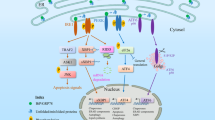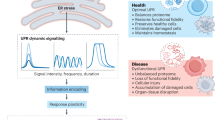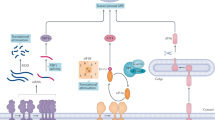Abstract
Canonical endoplasmic reticulum (ER) stress, which occurs in many physiological and disease processes, results in activation of the unfolded protein response (UPR). We now describe a new, evolutionarily conserved cellular stress response characterised by a striking, but reversible, reorganisation of ER membranes that occurs independently of the UPR, resulting in impaired ER transport and function. This reorganisation is characterised by a dramatic redistribution and clustering of ER membrane proteins. ER membrane aggregation is regulated, in part, by anti-apoptotic BCL-2 family members, particularly MCL-1. Using connectivity mapping, we report the widespread occurrence of this stress response by identifying several structurally diverse chemicals from different pharmacological classes, including antihistamines, antimalarials and antipsychotics, which induce ER membrane reorganisation. Furthermore, we demonstrate the potential of ER membrane aggregation to result in pathological consequences, such as the long-QT syndrome, a cardiac arrhythmic abnormality, arising because of a novel trafficking defect of the human ether-a-go-go-related channel protein from the ER to the plasma membrane. Thus, ER membrane reorganisation is a feature of a new cellular stress pathway, clearly distinct from the UPR, with important consequences affecting the normal functioning of the ER.
Similar content being viewed by others
Log in or create a free account to read this content
Gain free access to this article, as well as selected content from this journal and more on nature.com
or
Abbreviations
- CHOP:
-
C/EBP homologous protein
- CLL:
-
chronic lymphocytic leukaemia
- ER:
-
endoplasmic reticulum
- hERG:
-
human ether-a-go-go-related gene
- IRE1α:
-
inositol-requiring protein-1α
- LQTS:
-
long-QT syndrome
- MCL-1:
-
myeloid cell leukaemia 1
- NDGA:
-
nordihydroguaiaretic acid
- PERK:
-
protein kinase RNA-like ER kinase
- THG:
-
thapsigargin
- UPR:
-
unfolded protein response
- VSVG:
-
vesicular stomatitis viral glycoprotein
- XBP1:
-
X-box-binding protein 1
References
Hu J, Prinz WA, Rapoport TA . Weaving the web of ER tubules. Cell 2011; 147: 1226–1231.
Voeltz GK, Prinz WA, Shibata Y, Rist JM, Rapoport TA . A class of membrane proteins shaping the tubular endoplasmic reticulum. Cell 2006; 124: 573–586.
Baumann O, Walz B . Endoplasmic reticulum of animal cells and its organization into structural and functional domains. Int Rev Cytol 2001; 205: 149–214.
Lynes EM, Simmen T . Urban planning of the endoplasmic reticulum (ER): how diverse mechanisms segregate the many functions of the ER. Biochim Biophys Acta 2011; 1813: 1893–1905.
Ron D, Walter P . Signal integration in the endoplasmic reticulum unfolded protein response. Nat Rev Mol Cell Biol 2007; 8: 519–529.
Schroder M, Kaufman RJ . The mammalian unfolded protein response. Annu Rev Biochem 2005; 74: 739–789.
McCullough KD, Martindale JL, Klotz LO, Aw TY, Holbrook NJ . Gadd153 sensitizes cells to endoplasmic reticulum stress by down-regulating Bcl2 and perturbing the cellular redox state. Mol Cell Biol 2001; 21: 1249–1259.
Puthalakath H, O’Reilly LA, Gunn P, Lee L, Kelly PN, Huntington ND et al. ER stress triggers apoptosis by activating BH3-only protein Bim. Cell 2007; 129: 1337–1349.
Oakes SA, Lin SS, Bassik MC . The control of endoplasmic reticulum-initiated apoptosis by the BCL-2 family of proteins. Curr Mol Med 2006; 6: 99–109.
Rong Y, Distelhorst CW . Bcl-2 protein family members: versatile regulators of calcium signaling in cell survival and apoptosis. Annu Rev Physiol 2008; 70: 73–91.
Youle RJ, Strasser A . The BCL-2 protein family: opposing activities that mediate cell death. Nat Rev Mol Cell Biol 2008; 9: 47–59.
Lessene G, Czabotar PE, Colman PM . BCL-2 family antagonists for cancer therapy. Nat Rev Drug Discov 2008; 7: 989–1000.
Vogler M, Dinsdale D, Dyer MJ, Cohen GM . Bcl-2 inhibitors: small molecules with a big impact on cancer therapy. Cell Death Differ 2009; 16: 360–367.
Albershardt TC, Salerni BL, Soderquist RS, Bates DJ, Pletnev AA, Kisselev AF et al. Multiple BH3 mimetics antagonize antiapoptotic MCL1 protein by inducing the endoplasmic reticulum stress response and up-regulating BH3-only protein NOXA. J Biol Chem 2011; 286: 24882–24895.
Vogler M, Weber K, Dinsdale D, Schmitz I, Schulze-Osthoff K, Dyer MJ et al. Different forms of cell death induced by putative BCL2 inhibitors. Cell Death Differ 2009; 16: 1030–1039.
Orrenius S, Ericsson JL, Ernster L . Phenobarbital-induced synthesis of the microsomal drug-metabolizing enzyme system and its relationship to the proliferation of endoplasmic membranes. A morphological and biochemical study. J Cell Biol 1965; 25: 627–639.
Subramanian K, Meyer T . Calcium-induced restructuring of nuclear envelope and endoplasmic reticulum calcium stores. Cell 1997; 89: 963–971.
Lippincott-Schwartz J, Liu W . Insights into COPI coat assembly and function in living cells. Trends Cell Biol 2006; 16: e1–e4.
Iinuma T, Aoki T, Arasaki K, Hirose H, Yamamoto A, Samata R et al. Role of syntaxin 18 in the organization of endoplasmic reticulum subdomains. J Cell Sci 2009; 122 (Pt 10): 1680–1690.
Presley JF, Cole NB, Schroer TA, Hirschberg K, Zaal KJ, Lippincott-Schwartz J . ER-to-Golgi transport visualized in living cells. Nature 1997; 389: 81–85.
Wang G, Nikolovska-Coleska Z, Yang CY, Wang R, Tang G, Guo J et al. Structure-based design of potent small-molecule inhibitors of anti-apoptotic Bcl-2 proteins. J Med Chem 2006; 49: 6139–6142.
Oltersdorf T, Elmore SW, Shoemaker AR, Armstrong RC, Augeri DJ, Belli BA et al. An inhibitor of Bcl-2 family proteins induces regression of solid tumours. Nature 2005; 435: 677–681.
Lamb J, Crawford ED, Peck D, Modell JW, Blat IC, Wrobel MJ et al. The Connectivity Map: using gene-expression signatures to connect small molecules, genes, and disease. Science 2006; 313: 1929–1935.
Zhang SD, Gant TW . A simple and robust method for connecting small-molecule drugs using gene-expression signatures. BMC Bioinformatics 2008; 9: 258.
Zhang SD, Gant TW . sscMap: an extensible Java application for connecting small-molecule drugs using gene-expression signatures. BMC Bioinformatics 2009; 10: 236.
Kannankeril P, Roden DM, Darbar D . Drug-induced long QT syndrome. Pharmacol Rev 2010; 62: 760–781.
Sanguinetti MC, Tristani-Firouzi M . hERG potassium channels and cardiac arrhythmia. Nature 2006; 440: 463–469.
Mitcheson JS, Chen J, Lin M, Culberson C, Sanguinetti MC . A structural basis for drug-induced long QT syndrome. Proc Natl Acad Sci USA 2000; 97: 12329–12333.
Dennis A, Wang L, Wan X, Ficker E . hERG channel trafficking: novel targets in drug-induced long QT syndrome. Biochem Soc Trans 2007; 35 (Pt 5): 1060–1063.
Rajamani S, Eckhardt LL, Valdivia CR, Klemens CA, Gillman BM, Anderson CL et al. Drug-induced long QT syndrome: hERG K+ channel block and disruption of protein trafficking by fluoxetine and norfluoxetine. Br J Pharmacol 2006; 149: 481–489.
Wible BA, Hawryluk P, Ficker E, Kuryshev YA, Kirsch G, Brown AM . HERG-Lite: a novel comprehensive high-throughput screen for drug-induced hERG risk. J Pharmacol Toxicol Methods 2005; 52: 136–145.
Snapp EL, Hegde RS, Francolini M, Lombardo F, Colombo S, Pedrazzini E et al. Formation of stacked ER cisternae by low affinity protein interactions. J Cell Biol 2003; 163: 257–269.
Hetz C, Glimcher L . The daily job of night killers: alternative roles of the BCL-2 family in organelle physiology. Trends Cell Biol 2008; 18: 38–44.
Hatsuzawa K, Hirose H, Tani K, Yamamoto A, Scheller RH, Tagaya M . Syntaxin 18, a SNAP receptor that functions in the endoplasmic reticulum, intermediate compartment, and cis-Golgi vesicle trafficking. J Biol Chem 2000; 275: 13713–13720.
Sprocati T, Ronchi P, Raimondi A, Francolini M, Borgese N . Dynamic and reversible restructuring of the ER induced by PDMP in cultured cells. J Cell Sci 2006; 119 (Pt 15): 3249–3260.
Wang B, Heath-Engel H, Zhang D, Nguyen N, Thomas DY, Hanrahan JW et al. BAP31 interacts with Sec61 translocons and promotes retrotranslocation of CFTRDeltaF508 via the derlin-1 complex. Cell 2008; 133: 1080–1092.
Heidtman M, Chen CZ, Collins RN, Barlowe C . Yos1p is a novel subunit of the Yip1p-Yif1p complex and is required for transport between the endoplasmic reticulum and the Golgi complex. Mol Biol Cell 2005; 16: 1673–1683.
Alfa C, Fantes P, Hyams J, McLeod M, Warbrick E . Experiments with Fission Yeast: A Laboratory Course Manual. Cold Spring Harbor Laboratory Press: Woodbury, NY, USA, 1993.
Becattini B, Kitada S, Leone M, Monosov E, Chandler S, Zhai D et al. Rational design and real time, in-cell detection of the proapoptotic activity of a novel compound targeting Bcl-X(L). Chem Biol 2004; 11: 389–395.
Cockerill SL, Tobin AB, Torrecilla I, Willars GB, Standen NB, Mitcheson JS . Modulation of hERG potassium currents in HEK-293 cells by protein kinase C. Evidence for direct phosphorylation of pore forming subunits. J Physiol 2007; 581 (Part 2): 479–493.
Acknowledgements
We thank Drs Bratton, Downward, Glimcher, Harding, Mollard, Rosenberg and Shore for cells and reagents, and Professor A Willis for helpful discussions. We thank Judy McWilliam, Tim Smith and Kate Phillips for technical assistance, and the Medical Research Council for core support. We thank the NIH (grant CA149668 to MP) for support.
Author information
Authors and Affiliations
Corresponding author
Ethics declarations
Competing interests
The authors declare no conflict of interest.
Additional information
Edited by G Melino
Supplementary Information accompanies the paper on Cell Death and Differentiation website
Supplementary information
Rights and permissions
About this article
Cite this article
Varadarajan, S., Bampton, E., Smalley, J. et al. A novel cellular stress response characterised by a rapid reorganisation of membranes of the endoplasmic reticulum. Cell Death Differ 19, 1896–1907 (2012). https://doi.org/10.1038/cdd.2012.108
Received:
Revised:
Accepted:
Published:
Issue date:
DOI: https://doi.org/10.1038/cdd.2012.108
Keywords
This article is cited by
-
Cinnamaldehyde induces autophagy-mediated cell death through ER stress and epigenetic modification in gastric cancer cells
Acta Pharmacologica Sinica (2022)
-
Apogossypol-mediated reorganisation of the endoplasmic reticulum antagonises mitochondrial fission and apoptosis
Cell Death & Disease (2019)
-
The role of the endoplasmic reticulum protein calreticulin in mediating TGF-β-stimulated extracellular matrix production in fibrotic disease
Journal of Cell Communication and Signaling (2018)
-
A gene-signature progression approach to identifying candidate small-molecule cancer therapeutics with connectivity mapping
BMC Bioinformatics (2016)
-
Bcl-2 proteins and calcium signaling: complexity beneath the surface
Oncogene (2016)



